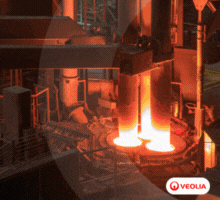Duplex Outperforms Mild Steel in Bridge Lifecycle Analysis
04/27/2015 - The use of duplex stainless steel in the construction of the new Myllysilta bridge in Finland generated significant environmental benefits over the alternative mild steel option, including a 62% reduction in global warming potential, a new lifecycle analysis study has concluded.
A lifecycle analysis (LCA) study compared the total environmental impacts of the selected approach using duplex stainless steel with the mild steel alternative, focusing on aspects of the cladding lifecycle that differ between the two solutions. This included a three-layer zinc-epoxy paint treatment for the mild steel option to protect against corrosion, which was not necessary for the duplex stainless steel. It also included any maintenance and replacement required within the 100-year design life and the impacts and benefits related to recycling the cladding at end-of-life.
The LCA compared the environmental impacts of the two materials and any potential trade-offs between lifecycle phases, focussing on relevant metrics including contribution to global warming, eutrophication, photochemical ozone creation and the consumption of non-renewable energy sources.
As well as reducing the global warming potential by 62%, the study demonstrated that the duplex stainless steel option saved 67% of the eutrophication potential (the production of pollutants which damage aquatic life) and used 38% less non-renewable energy over the estimated lifetime of the bridge, compared to using mild steel. The selected option also reduced photochemical ozone creation potential by 99% by dispensing with the need for anti-corrosion paint which contains high levels of volatile organic compounds (VOCs).
Commenting on the study. Tim Outteridge, IMOA Secretary-General said: “This study demonstrates the effectiveness of molybdenum-containing stainless steels in protecting installations from the effects of chloride corrosion. Properly specified, the use of materials such as duplex stainless steel can not only deliver exceptional performance but can also generate significant environmental benefits.”
The study was commissioned by IMOA and conducted by WSP. The full case study is available on the IMOA website: www.imoa.info.
IMOA is a non-profit trade association representing the interests of most of the world’s molybdenum producers and converters, as well as consumers and traders. Molybdenum is added to steels and cast irons to improve strength, toughness, hardenability and weldability for numerous applications in the automotive, shipbuilding, construction, mining, chemical, oil & gas and energy generation industries. In stainless steels and superalloys, it improves corrosion resistance and high-temperature performance and finds uses in many industrial applications. It is also used in a variety of products from catalysts and lubricants to pigments and paint.



.jpg?lang=en-US&ext=.jpg)
-(1).gif?width=220&height=200&mediaprotectionhash=8011a71ede637cd523c67b1296fc49e6151560fde821a46f29cc85998cc76615&ext=.gif)



